On June 16, 1940, the Germans celebrate the occupation of Paris. The beaten and demoralized French army lay down their arms en masse. The British are licking the wounds of the evacuation from Dunkirk. Only Poles do not give up. The 10th Armored Cavalry Brigade of General Maczek recaptures the town of Montbard from the Germans in a short battle.
As early as October 1939, entire units of Polish soldiers from the 10th Motorized Cavalry Brigade began to arrive in France from internment in Hungary. Polish plans to reactivate this unit, this time in the form of a light mechanized division, met with resistance from French allies. Only in May 1940, under the influence of a difficult situation at the front, they agreed to create a Polish armored unit.

Renault R-40 of the 10th Armored Cavalry Brigade. These tanks found their way to the Polish unit in greater numbers after the Germans attacked France (source:public domain; RK colorization) ..
This time the French pressed to send Poles to the front as soon as possible! Eventually, after Gen. Sikorski's intervention with Gen. Weygand, a combat group was formed from the separate subunits of the still defunct armored division. The new unit was named the 10th Armored Cavalry Brigade (10th BKPanc), and its command was entrusted to Brig. Stanisław Maczek.
The Polish brigade consisted of a Renault R-35 tank battalion, 10th Dragoons Squadron, 24th Uhlan Regiment, 10th Mounted Rifle Regiment, 25mm and 47mm Anti-Tank Cannons Squadron, 25mm Anti-Aircraft Cannon Battery and a Sapper Company. Together, it was just over 1.7 thousand. soldiers.
At the front
On June 10, the brigade was operationally subordinate to the French 4th Army operating in Champagne and was tasked with protecting its west wing. On June 12, when the order to retreat was issued, the Poles were subordinated to the 7th corps of the 6th army. Faced with the threat of encircling his unit, the French commander intended to use the Polish brigade in the Lucy and Montmort area for defense or counterattack. Thanks to this, the French divisions were to break away from the enemy.
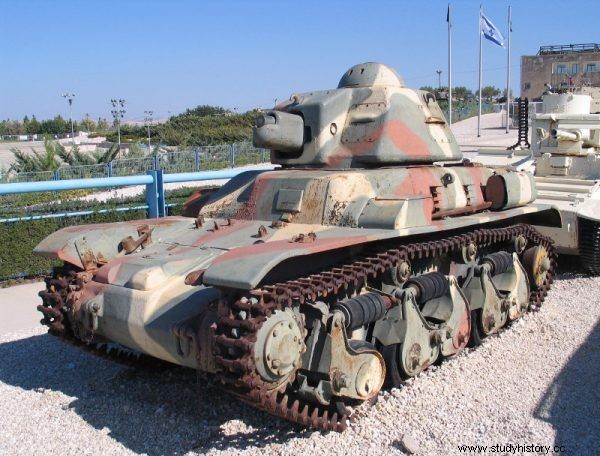
Such tanks were received by the 10th Armored Cavalry Brigade of General Maczek (photo:Bukvoed, CC BY-SA 3.0).
The next day, the effective defense of the Poles made it possible for the French 20th infantry division to retreat. Our soldiers fought fierce skirmishes with German reconnaissance patrols, and at the village of Champaubert they rejected the attack of the German infantry supported by tanks. The first losses in people and equipment were made.
Then, near the town of Montigivroux, the Polish Renault R-35 successfully counterattacked together with the motorized cavalry against the German reconnaissance unit, which was trying to cut off the troops of the 20 infantry divisions. This action was carried out despite the earlier bombing of Polish positions by the German air force, including the lethally effective Stukas.
New Orders
Throughout June 15, the Poles covered the retreat of another French unit, this time of the 2nd infantry division. The next morning, the brigade received new orders:to get crossings through the Burgundy Canal in the town of Montbard. This was to enable the withdrawal of the French 42nd infantry division. How many times in these few days was the brigade involved in saving the skins of the French allies?
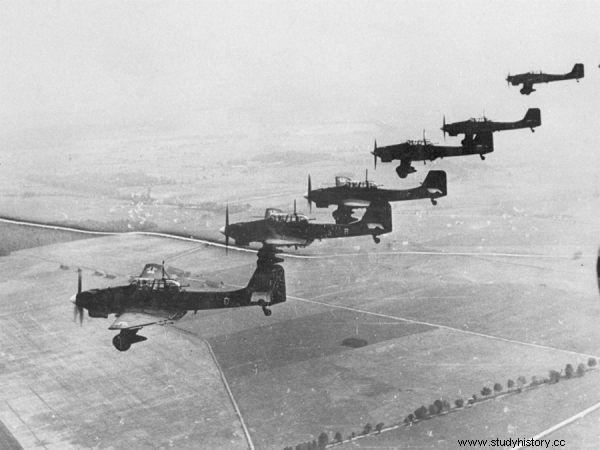
The attack of the formidable stukas did not break the Polish armorers (photo Bundesarchiv, Bild 183-1987-1210-502 / Heinrich Hoffmann / CC-BY-SA).
These guidelines were hard to crack for General Maczek. The reason was prosaic:there was no fuel. And there were no signs that they would be completed in the near future. Meanwhile, Montbard was approximately 60 kilometers away.
There was only one way out of the situation. Poles with a heavy heart had to destroy some of the carts and pour fuel on the others. In the end, only one company of seventeen Renault R-35 tanks was to move to Montbard. In addition, the strike forces included:two motorized cavalry squadrons, a platoon of motorcyclists, a company of engineers, a squadron of anti-tank guns 47 mm and a battery of anti-aircraft guns.
Forward! For Warsaw!
In the evening, the Polish unit took up positions in the forests surrounding Montbard. There, General Maczek briefed his officers. He reminded them of the injustice they had to compensate for the Germans.
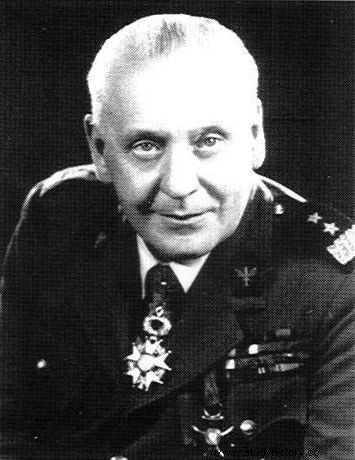
The successes of General Stanisław Maczek's brigade during the 1940 campaign foreshadowed victories four years later (photo:public domain).
The order to attack was short: march forward to Montbard; upon receiving the fire - set full throttle to the city, crushing everything that resists; the subject of the attack - the bridge over the canal. Lt. Col. Majewski's tanks were to go to the front, followed by cavalrymen of Lt. Niepokoyczycki's 2nd squadron.
Nightfall
The Poles set off in the dark. Gen Maczek and his staff took a position on a hill, a few hundred meters from the city limits. Around 22 of our units came across German detectors. The German walkers scattered without firing a single shot.
At the first town buildings, the Renówka headed by a well-aimed shot destroyed a German armored car. The fire of the machine guns of Polish tanks and cavalry rifles also killed the service of the 88 mm anti-aircraft gun. The famous German "acht-acht", deadly to tanks, did not manage to fire a single shot.
However, the Germans also woke up eventually. The Polish ranks were hit by machine gun bursts. Renews then developed in a wide range. Cavalry stubbornly followed them. Tanks entered the town buildings, firing heavily.
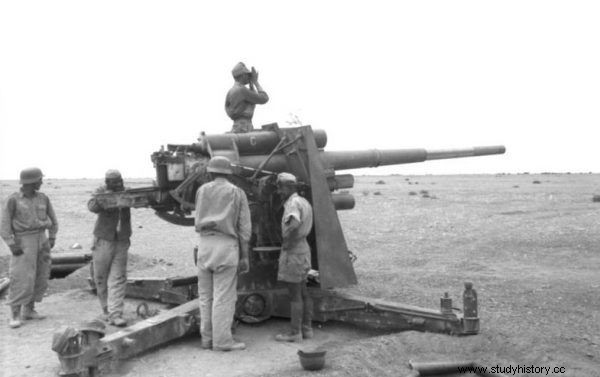
The famous 88 mm anti-aircraft gun was deadly to tanks (photo Bundesarchiv, Bild 101I-443-1574-26 / Ernst A. Zwilling / CC-BY-SA).
Between the platoons of Polish cavalrymen, the following commands were given :Bagnet for a weapon! Unlock the grenades! Lieutenant Niepokoyczycki loudly shouted the order: For the assault! Hooray! Two hundred throats gave him a long, long hooray! There was a roar of grenades. Poles fell into the town like hell after the tanks. They quickly broke through the outer line of defense of the Germans, then engaged the enemy in hand-to-hand combat.
Support arrives
Polish units fighting in the city were supported by the rest of the brigade's forces. The 1st motorized cavalry squadron of Captain Ejsymont and sappers of Major Zgorzelski came to the rescue. Poles began to comb the city along and across. They were taking down German resistance points one by one.
The Germans did not withstand this surprise night attack and retreated beyond the Burgundy Canal. As it turned out later, the enemy of our armored units was the 66th regiment of the 13th Motorized Division. The action of the Polish brigade put the entire German division on alert. All crossings on the canal were densely manned by her troops.
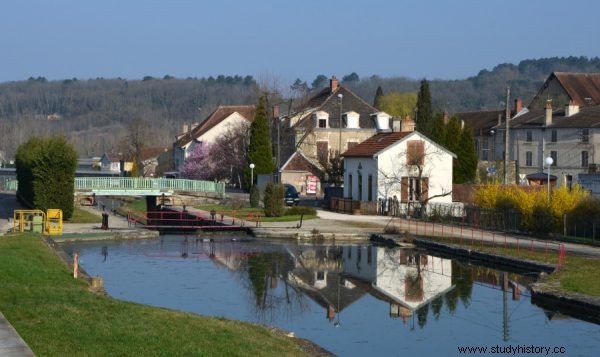
This is what the Burgundy Canal looks like today in Montbard (photo:Pline, CC BY-SA 3.0).
Around 1.30 the whole city was in Polish hands. A dozen or so prisoners were taken. Lieutenant Colonel Skibiński recalled that the soldiers of the Wehrmacht were shocked by the Polish attack: For a long time they had become unaccustomed to encountering any resistance, and by no means anticipated a night attack on the city with tanks ...
The joy of victory…
The Poles captured three anti-tank guns and one anti-aircraft gun, a few heavy machine guns, a few cars and a dozen motorcycles. About 60 bodies of German soldiers were lying on the battlefield. Our losses amounted to 17 killed and approximately 30 wounded (including Captain Ejsymont) and three tanks. It was spoiled by the fact that the Germans managed to blow up the bridge being the target of the attack.
The location of the Polish brigade was very difficult. Gen. Maczek considered the possibility of a German counterattack, but he had too little strength to be able to keep the town in the long run. The staff also received information about the change of the route of the 42nd division, which, however, was to bypass Montbard and headed south-east. The effort of the Polish soldiers seemed to be in vain.
… and the bitterness of defeat
10 BKPanc left Montbard around 2.00. On June 17, it reached the Is-sur-Tille area near Dijon. Further march as a whole unit was impossible, the German encirclement finally tightened around the Poles. On June 18, the Brigade ceased to exist as a compact combat force.
On the orders of General Maczek, the rest of the vehicles and heavy weapons were destroyed. The last five hundred soldiers, divided into small groups, moved south towards French ports. Most of them managed to evacuate to Great Britain. In August 1944, they returned to France as part of the 1st Armored Division. Gen. Maczek's soldiers were to taste the victory.
